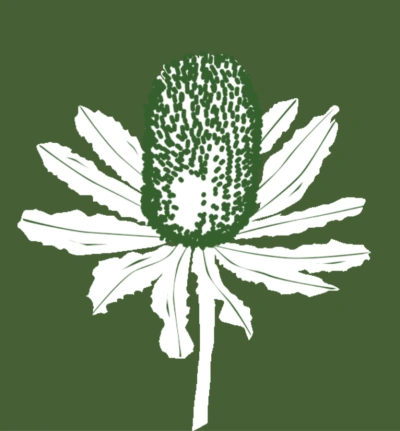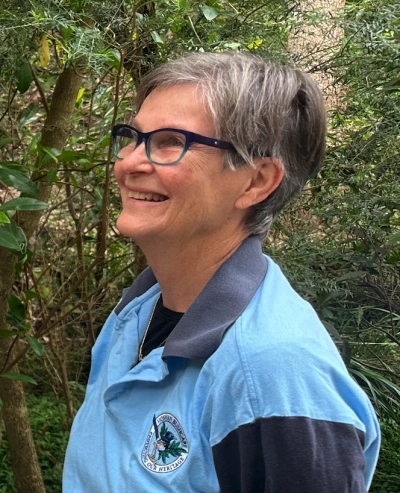Learning from the Bradley Sisters’ Bush regeneration method
The Bradley sisters were at a time [in the 1960s and 1970s] where there seemed to be a large interest in protecting the bush. One of them had a science degree, and the precision and the exactness that she had writing her notes, the details that they went into - they knew what they were talking about, and the [Bradley Bush regeneration] technique [that they pioneered] works.
I think that's what's so good, that they spent so much time doing different ways, and then pulling it all together and finding a way [of bush regeneration] that works - [the ‘Bradley Method’] - so that you're actually getting bush regeneration through natural methods.
Applying the Bradley Sisters’ method to regenerate Mosman bushland today
The history of the park across the road from us is that the land belonged to the [Taronga Park] zoo, and they needed money. The zoo put the land up and they wanted to build houses. They divided it up into four blocks. There was a huge fight. The locals didn't want more cars coming in - it's a narrow area. They convinced the state government to transfer the land to the council who took the responsibility for it.
For a number of years it laid fallow and nobody did anything about it. Then some of the neighbours wrote into the council, complaining about how it was becoming a dumping ground. It was full of [invasive weeds such as] lantana and morning glory and it was unsightly. So they decided to split the site in two. One half of it going down to the curve is maintained by the council, who keeps it clear, and they do replanting.
From the curve onto the zoo bordering the zoo fence line, we [local volunteers] do bush regeneration and we follow the Bradley Method. There is a bit of poisoning that goes on for major weeds. There's still a lot of work to be done but you can see the structure coming through and some of the plants are regenerating.
We are [now] seeing the fruits of our work, and it’s fantastic… Since the bushland has been [regenerating] across the road, I've been getting more Native [birds back again] so it's hopeful, but not easy. It hasn't brought back the little birds yet and that would be my aim but we need much more undergrowth. [Our bush here] is open and has a good high tree canopy. So when the eucalypts are flowering, you can hear the bats coming through. We have a powerful owl that sort of flits through the area, and I've had him here in the garden.

Mosman Parks and Bushland Association

Margaret Woodforth
Learning from the Bradley Sisters’ Bush regeneration method
The Bradley sisters were at a time [in the 1960s and 1970s] where there seemed to be a large interest in protecting the bush. One of them had a science degree, and the precision and the exactness that she had writing her notes, the details that they went into - they knew what they were talking about, and the [Bradley Bush regeneration] technique [that they pioneered] works.
I think that's what's so good, that they spent so much time doing different ways, and then pulling it all together and finding a way [of bush regeneration] that works - [the ‘Bradley Method’] - so that you're actually getting bush regeneration through natural methods.
Applying the Bradley Sisters’ method to regenerate Mosman bushland today
The history of the park across the road from us is that the land belonged to the [Taronga Park] zoo, and they needed money. The zoo put the land up and they wanted to build houses. They divided it up into four blocks. There was a huge fight. The locals didn't want more cars coming in - it's a narrow area. They convinced the state government to transfer the land to the council who took the responsibility for it.
For a number of years it laid fallow and nobody did anything about it. Then some of the neighbours wrote into the council, complaining about how it was becoming a dumping ground. It was full of [invasive weeds such as] lantana and morning glory and it was unsightly. So they decided to split the site in two. One half of it going down to the curve is maintained by the council, who keeps it clear, and they do replanting.
From the curve onto the zoo bordering the zoo fence line, we [local volunteers] do bush regeneration and we follow the Bradley Method. There is a bit of poisoning that goes on for major weeds. There's still a lot of work to be done but you can see the structure coming through and some of the plants are regenerating.
We are [now] seeing the fruits of our work, and it’s fantastic… Since the bushland has been [regenerating] across the road, I've been getting more Native [birds back again] so it's hopeful, but not easy. It hasn't brought back the little birds yet and that would be my aim but we need much more undergrowth. [Our bush here] is open and has a good high tree canopy. So when the eucalypts are flowering, you can hear the bats coming through. We have a powerful owl that sort of flits through the area, and I've had him here in the garden.
Love what you're reading? Support Mosman Parks and Bushland Association donate to support them now
Donate hereYou might like...

On Folktales and conservation: Mararison Island

Nature Is Speaking – Julia Roberts is Mother Nature Conservation International (CI)

Genetic diversity and saving the forty spotted Pardalote

From hunter, to guardian: the inspiring journey of Benjamin Tacud and the fight to save the dulungan
Newsletter
Sign up to keep in touch with articles, updates, events or news from Kuno, your platform for nature
